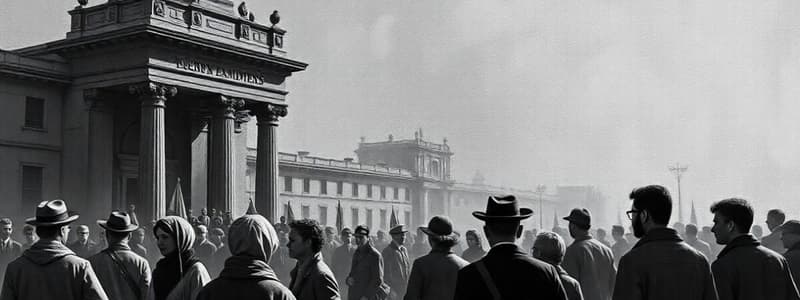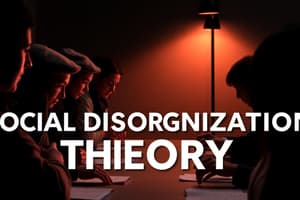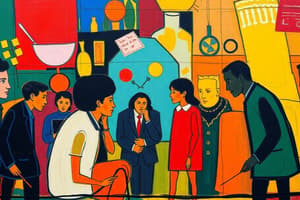Podcast
Questions and Answers
According to Durkheim, what is a primary factor influencing suicide rates?
According to Durkheim, what is a primary factor influencing suicide rates?
- Economic hardship and poverty levels within a community.
- The degree of social integration and connectedness within a society. (correct)
- The availability and access to lethal methods of self-harm.
- Individual psychological disorders and genetic predispositions.
How did the Chicago School explain the high crime rates in the transitional zones of the city?
How did the Chicago School explain the high crime rates in the transitional zones of the city?
- As a result of intensive policing strategies that targeted these areas disproportionately.
- Due to the higher proportion of unemployed individuals lacking legitimate economic opportunities.
- Because of social disorganization and the absence of strong communal institutions to integrate residents. (correct)
- Due to the concentration of recent immigrants who brought criminal traditions from their home countries.
What is a key criticism of the social disorganization theory developed by the Chicago School?
What is a key criticism of the social disorganization theory developed by the Chicago School?
- The theory overemphasized the role of criminal organizations in providing social support.
- Researchers did not adequately assess actual levels of organization within the supposedly 'disorganized' communities. (correct)
- The model assumed all residents were striving for upward mobility and economic success.
- The sociologists failed to account for the psychological factors contributing to crime.
According to Robert Merton's strain theory, what primarily causes strain that can lead to crime?
According to Robert Merton's strain theory, what primarily causes strain that can lead to crime?
According to strain theory, how might a 'criminal innovator' respond to societal strain?
According to strain theory, how might a 'criminal innovator' respond to societal strain?
According to Albert Cohen's perspective on strain theory, why do juveniles engage in delinquent behavior?
According to Albert Cohen's perspective on strain theory, why do juveniles engage in delinquent behavior?
If strain theory is accurate, which of the following strategies would be most effective in reducing crime?
If strain theory is accurate, which of the following strategies would be most effective in reducing crime?
What is a primary criticism of strain theory?
What is a primary criticism of strain theory?
What is the central question that social control theory seeks to answer?
What is the central question that social control theory seeks to answer?
According to Hirschi's social bond theory, what are the key elements that bind individuals to the social order?
According to Hirschi's social bond theory, what are the key elements that bind individuals to the social order?
If social control theory is correct, which intervention strategy would be most effective for reducing crime?
If social control theory is correct, which intervention strategy would be most effective for reducing crime?
What is a major critique of social control theory?
What is a major critique of social control theory?
According to differential association theory, how do individuals learn to engage in criminal behavior?
According to differential association theory, how do individuals learn to engage in criminal behavior?
What did Edwin Sutherland contribute to the study of crime, beyond differential association theory?
What did Edwin Sutherland contribute to the study of crime, beyond differential association theory?
According to differential association theory, what factors determine the impact of exposure to criminal definitions?
According to differential association theory, what factors determine the impact of exposure to criminal definitions?
What is a potential consequence of labeling someone as a criminal?
What is a potential consequence of labeling someone as a criminal?
What is a 'perp walk' and how does it relate to labelling theory?
What is a 'perp walk' and how does it relate to labelling theory?
According to Lemert's approach to labeling theory, how does the social reaction to an initial act of deviance potentially lead to more crime?
According to Lemert's approach to labeling theory, how does the social reaction to an initial act of deviance potentially lead to more crime?
What is the difference between primary and secondary deviance, according to labeling theory?
What is the difference between primary and secondary deviance, according to labeling theory?
What is a key area of focus in critical criminology?
What is a key area of focus in critical criminology?
How did feminist criminology emerge and challenge traditional criminology?
How did feminist criminology emerge and challenge traditional criminology?
What is the 'liberation/emancipation hypothesis' in feminist criminology, and why has it been largely unsupported by empirical data?
What is the 'liberation/emancipation hypothesis' in feminist criminology, and why has it been largely unsupported by empirical data?
How does power-control theory explain gender differences in crime?
How does power-control theory explain gender differences in crime?
What changes occurred in the legal treatment of sexual assault due to feminist critiques?
What changes occurred in the legal treatment of sexual assault due to feminist critiques?
What are some characteristics of an 'ideal victim' in the context of sexual assault cases?
What are some characteristics of an 'ideal victim' in the context of sexual assault cases?
What is 'coercive control' and what is its significance in the context of domestic violence?
What is 'coercive control' and what is its significance in the context of domestic violence?
What is 'pathways research' in the context of feminist criminology?
What is 'pathways research' in the context of feminist criminology?
What is the 'victim-offender overlap' and why is it significant in the context of crimes against women?
What is the 'victim-offender overlap' and why is it significant in the context of crimes against women?
Which of the following statements best reflects feminist contributions to understanding crime?
Which of the following statements best reflects feminist contributions to understanding crime?
How does the concept of 'collective efficacy' relate to social disorganization theory?
How does the concept of 'collective efficacy' relate to social disorganization theory?
What broad change is feminist criminology credited with?
What broad change is feminist criminology credited with?
A man with a criminal record applies for numerous jobs but is consistently rejected due to his past. How might this be explained by strain and labeling theories?
A man with a criminal record applies for numerous jobs but is consistently rejected due to his past. How might this be explained by strain and labeling theories?
How do social disorganization and social control theories differ in their approach to explaining crime?
How do social disorganization and social control theories differ in their approach to explaining crime?
Some research indicates that individuals with strong social bonds can still engage in crime. How does this critique challenge core assumptions of social control theory?
Some research indicates that individuals with strong social bonds can still engage in crime. How does this critique challenge core assumptions of social control theory?
How can the impact of labeling be mitigated when dealing with offenders to reduce recidivism?
How can the impact of labeling be mitigated when dealing with offenders to reduce recidivism?
What is the primary focus of criminal justice workers regarding labeling theory?
What is the primary focus of criminal justice workers regarding labeling theory?
According to Durkheim, how does urbanization influence social solidarity and, consequently, deviance?
According to Durkheim, how does urbanization influence social solidarity and, consequently, deviance?
How does the concept of 'collective efficacy' expand upon the earlier 'social disorganization' theory from the Chicago School?
How does the concept of 'collective efficacy' expand upon the earlier 'social disorganization' theory from the Chicago School?
How does Merton's concept of 'anomie' differ from Durkheim's original formulation of the term?
How does Merton's concept of 'anomie' differ from Durkheim's original formulation of the term?
According to Robert Merton's strain theory, what is the primary motivator for 'innovation' as a form of adaptation to strain?
According to Robert Merton's strain theory, what is the primary motivator for 'innovation' as a form of adaptation to strain?
How does Albert Cohen's theory of delinquent subcultures extend the traditional understanding of strain theory?
How does Albert Cohen's theory of delinquent subcultures extend the traditional understanding of strain theory?
A community implements a program to improve educational and job opportunities in low-income areas. How would this initiative align with the principles of strain theory?
A community implements a program to improve educational and job opportunities in low-income areas. How would this initiative align with the principles of strain theory?
What critical question does social control theory pose that distinguishes it from many other criminological theories?
What critical question does social control theory pose that distinguishes it from many other criminological theories?
According to Hirschi's social bond theory, which of the following scenarios would be LEAST likely to result in criminal behavior?
According to Hirschi's social bond theory, which of the following scenarios would be LEAST likely to result in criminal behavior?
Which policy intervention would align with the principles of social control theory concerning the prevention of crime?
Which policy intervention would align with the principles of social control theory concerning the prevention of crime?
What is the key mechanism through which criminal behavior is learned, according to differential association theory?
What is the key mechanism through which criminal behavior is learned, according to differential association theory?
According to differential association theory, what is most influential in determining whether someone will engage in criminal behavior?
According to differential association theory, what is most influential in determining whether someone will engage in criminal behavior?
What is a significant potential consequence of formally labeling someone as a 'criminal'?
What is a significant potential consequence of formally labeling someone as a 'criminal'?
According to labeling theory, how can the formal application of a 'criminal' label affect an individual's future behavior?
According to labeling theory, how can the formal application of a 'criminal' label affect an individual's future behavior?
How does critical criminology challenge traditional understandings of crime and the criminal justice system?
How does critical criminology challenge traditional understandings of crime and the criminal justice system?
What is the central argument of power-control theory regarding gender differences in crime rates?
What is the central argument of power-control theory regarding gender differences in crime rates?
Flashcards
Emile Durkheim
Emile Durkheim
Originator of sociology as an academic discipline, whose approach to suicide is relevant to strain theory.
Social Solidarity
Social Solidarity
The togetherness and shared goals/norms often found in small villages.
Concentric Ring Model
Concentric Ring Model
A model that maps crime in transitional zones (ring #2) due to social disorganization.
Collective Efficacy
Collective Efficacy
Signup and view all the flashcards
Strain Theory
Strain Theory
Signup and view all the flashcards
Anomie
Anomie
Signup and view all the flashcards
Innovation (Strain Theory)
Innovation (Strain Theory)
Signup and view all the flashcards
Albert Cohen's Strain Theory
Albert Cohen's Strain Theory
Signup and view all the flashcards
Strain Theory Solutions
Strain Theory Solutions
Signup and view all the flashcards
Social Control Theory
Social Control Theory
Signup and view all the flashcards
Social Bond Theory
Social Bond Theory
Signup and view all the flashcards
Attachments (Social Control)
Attachments (Social Control)
Signup and view all the flashcards
Commitments (Social Control)
Commitments (Social Control)
Signup and view all the flashcards
Involvement (Social Control)
Involvement (Social Control)
Signup and view all the flashcards
Beliefs (Social Control)
Beliefs (Social Control)
Signup and view all the flashcards
Policies Based on Social Bond Theory
Policies Based on Social Bond Theory
Signup and view all the flashcards
Differential Association Theory
Differential Association Theory
Signup and view all the flashcards
What is Learned (Differential Association)
What is Learned (Differential Association)
Signup and view all the flashcards
White Collar Crime
White Collar Crime
Signup and view all the flashcards
Crucial Factors (Differential Association)
Crucial Factors (Differential Association)
Signup and view all the flashcards
Common Cultural Needs
Common Cultural Needs
Signup and view all the flashcards
Labeling Suspensions
Labeling Suspensions
Signup and view all the flashcards
Power and Labeling
Power and Labeling
Signup and view all the flashcards
Deviance as a Label
Deviance as a Label
Signup and view all the flashcards
Perp Walk
Perp Walk
Signup and view all the flashcards
Primary Deviance
Primary Deviance
Signup and view all the flashcards
Secondary Deviance
Secondary Deviance
Signup and view all the flashcards
Critical Criminology
Critical Criminology
Signup and view all the flashcards
Feminism (1970s Definition)
Feminism (1970s Definition)
Signup and view all the flashcards
Feminist Criminology
Feminist Criminology
Signup and view all the flashcards
Liberation/Emancipation Hypothesis
Liberation/Emancipation Hypothesis
Signup and view all the flashcards
Power Control Theory
Power Control Theory
Signup and view all the flashcards
Sexual Assault Statutes (Canada)
Sexual Assault Statutes (Canada)
Signup and view all the flashcards
Ideal Victim (SA)
Ideal Victim (SA)
Signup and view all the flashcards
Criminalizing Coercive Control
Criminalizing Coercive Control
Signup and view all the flashcards
Pathways Research
Pathways Research
Signup and view all the flashcards
Victim-Offender Overlap
Victim-Offender Overlap
Signup and view all the flashcards
Study Notes
- Émile Durkheim is the originator of sociology as an academic discipline.
- Durkheim's approach to suicide is relevant to strain theory.
- Suicide rates vary across time and places, similar to crime rates.
- Closeness or lack of closeness to others causes suicide.
Social Solidarity
- Small villages have similar ideas, togetherness, shared goals, and norms.
- Urbanization led to upheavals from small communities and increased mixing of different people and ideas.
The Chicago School/Social Disorganization Theory
- Chicago became a lab for sociologists, leading to ethnographies.
- Concentric ring model maps of Chicago found high crime in ring number 2, the transitional zone.
- Social disorganization, without established institutions that integrate people, leads to higher crime rates.
- A key critique is that they didn’t check if neighborhoods were actually "organized".
- Criminal organizations can contribute to social supports.
- The theory was criticized as racist for suggesting that the mixing of ethnicities creates crime due to differing beliefs.
Collective Efficacy
- Collective efficacy equals social organization.
- It gauges how well a community can unite to address challenges through community organization, moral supports, and trust.
Strain/Anomie Theory
- Robert Merton used Durkheim's concept of anomie to explain crime.
- Strain arises from the discrepancy between culturally defined goals and the institutionalized means to achieve them.
- An example cultural goal is to be a contributing member of society.
- Merton's theory is rooted in the American cultural context, similar to Canadian ideals, often referred to as the "American Dream".
- Anomie occurs when societal organization places strain on individuals, leading to rule-breaking behavior.
- The problem isn't a lack of norms but an inability to meet goals.
- The inability to achieve the "American Dream" causes strain.
- Hard work alone is often insufficient due to other contributing factors such as privilege.
- The dominant goal in many countries is wealth acquisition.
- Hard work and education are supposedly required to achieve material success, which may not always be the case.
- Strain or anomie results when legitimate means for achieving material success are not uniformly distributed.
- Criminals, in this theory, innovate clever paths to achieve goals.
- When cultural goals encourage desires difficult for certain groups to attain, those groups experience strain and are more likely to turn to deviance.
- The main mistake is focusing on money, instead of the goals and norms of your country.
- Long-term focus is on goals such as university, marriage, and children, rather than short-term survival.
Albert Cohen's Take on Strain
- Distinguish whose strain theory is being used.
Juvenile Delinquency
- Classic strain theory is difficult to apply to crimes committed by youth, such as underage drinking, vandalism, or underage driving.
- These actions don't align with cultural goals or the "American Dream."
- Cohen looks at gangs and youth in gangs as their own subculture.
- Youth seek to achieve success within the subculture, not the conventional culture.
- These goals are more realistic for people marginalized from the American Dream.
- Working-class youth struggle in the educational system and turn to delinquent subcultures to gain status.
- Addressing strain to reduce crime involves creating more equally available opportunities.
- One can give people more of an equal playing field.
- One should critically examine the values and goals deemed important.
Critiques of Strain Theory
- It doesn’t explain why rich and powerful people break rules or engage in crime.
- Women are statistically less likely to commit crimes, despite facing more strain than men.
Social Control Theory
- Conformity, not deviance, needs explanation.
- People refrain from deviance due to processes binding them to the social order.
Hirschi and Social Bond/Control Theory
- Individuals with weaker social bonds are more likely to turn to deviance.
- Beliefs about the law can influence.
- Social control theory views society as institutions controlling rule-breaking behavior.
- Broken or weak social bonds can lead to succumbing to egocentric impulses and engaging in crime.
Social Bonds
- Attachments: Emotional ties to and respect for the opinions of groups like family and close friends.
- Commitments: Investment or stake in conforming behavior like school or work.
- Involvement: Being busy with activities minimizes time to commit crimes.
- Beliefs: Loyalty to a value system, including morals, religion, and the legitimacy of the law.
- Education for young people, parents, and authority figures is required.
- Kids turning to crime often come from fragmented families causing stress.
- Fostering healthy, safe home environments is important.
- One should eliminate social divisions and create stronger communities with better social bonds.
- Addressing root inequalities to create better conditions for children is important.
- One can create community, eliminate social divisions, and educate.
- Policy approaches should target schools.
Critiques of Social Control Theory
- It doesn’t account for more serious youth crimes or adult crimes.
- Involvement and strong bonds to conventional society don’t guarantee protection from all forms of crime and deviance.
- It assumes that the four components relate to conforming behavior.
- Social disorganization theory examined community-level controls.
- Crime occurs in "disorganized" communities experiencing high levels of strain/anomie.
Differential Association Theory (Edwin Sutherland)
- People learn how to engage in crime.
- One learns the techniques such as "tricks of the trade" and the rules.
- Learning occurs through interaction with others who have already learned criminal ways.
- What is learned are criminal techniques, motives, attitudes, and rationalizations.
- This can be learned from peers who have more knowledge and experience.
- Edwin Sutherland created the concept of white-collar crime.
- He argued that crime was associated with lower classes.
- He uncovered the existence of white-collar crimes.
- People with common interests stick together, such as opportunities, status, and wealth.
- One acquires a criminal attitude by associating with those who commit crimes.
- Criminal behavior responds to the same cultural needs and values as non-criminal behavior, like wealth and status.
- Exposure to particular definitions (frequency and intensity) at the point of interaction is crucial for explaining criminal activity.
- Symbols indicating criminality include colors, tattoos, and clothing.
- Consequences of being labeled a criminal include a criminal record and social outcasting.
- A criminal record check is often used to ensure the offense doesn’t align with the next activity or to prevent working with children.
- Those with criminal records may face poverty.
- Those who cannot get a job because of their criminal record may turn back to a life of crime.
- This increases strain/anomie, or labeling theory where being labeled a criminal becomes a self-fulfilling prophecy.
- Making consequences of labeling less severe (labeling suspensions) is a policy tool being considered.
Labeling Theory (Social Constructivist Approach)
- Some groups or individuals have more power to force the deviant label on the less powerful.
- Deviance is not a quality of an act but a label.
- The accused is sometimes treated like a dangerous animal, influencing jury and judge verdicts.
- How people are portrayed in courtrooms can impact perceptions of guilt or innocence.
- The perp walk is when authorities make a person recreate their "crime" for the media.
- The perp walk makes people think that suspects are guilty before they've been proven guilty.
- Suspects are presumed innocent but treated as if already convicted, meant to please journalists and change social standing.
- Police parade them in front of cameras to humiliate and show they are criminals before conviction.
- Not common in Canada but is common in the US.
- People can be labeled as criminals before conviction.
- The Netflix documentary "American Nightmare" shows that after a couple reported a home invasion and kidnapping, the police accused them of making it up.
- The police found similarities between their story and the movie "Gone Girl."
- The police then apprehended someone responsible, but the couple found the "liar" label hard to shake.
- Notions are created, and when reinforced by powerful interests, they can be hard to shake.
- Response to criminality can lead to more crime.
- Someone commits a minor crime, like smoking weed or shoplifting.
- When they are caught and labeled as a criminal, their life course, opportunities, and identities change.
- People internalize the criminal label and act accordingly, potentially hindering self-correction.
Limitations of Labeling Theory
- Some people commit crimes for a long time in secret without being labeled.
- Primary deviance is the initial act of deviance.
- Secondary deviance is when the label is internalized following societal reaction.
- Mitigating this involves not labeling people too much and providing opportunities to escape the label.
Critical Criminology (Relates to Conflict Theory)
- Think about who is really being served by laws, and criminal justice.
- Some types of crimes are favored, such as white-collar crime.
- People in upper socioeconomic classes aren't punished as much as the poor.
- Theories, with the presumption of male offenders, should apply to females and women.
- Feminist criminology has helped change social attitudes and criminal justice system responses to issues like sexual assault and domestic violence.
- Prior to the late 1960s and early 1970s, criminologists tended to ignore explaining women’s criminality.
- Ideas of female criminality were restricted to the sexual realm or to biological differences.
- Carol Smart (1976) in the UK; Freda Adler (1975), Rita Simon (1975) in the US originated the feminist criminological perspective.
- Since the 1970s, mainstream approaches to explaining crime came under increasing scrutiny and critique based on gender.
- Theories of crime should cut across gender, and ideas about criminals shouldn’t just apply to men.
- Patriarchy has codified women as property of fathers or husbands.
- Changes in the 80s were due to feminist critiques.
- The critiques need to be reemphasized, as it's hard to say how much has changed socially and legally.
- Liberation/emancipation hypothesis links the differences to unequal levels of power.
- Men committed more crimes due to their higher social status.
- It was believed equalizing power between men and women would create more equality in crime rates.
- Data has not supported this theory that women started committing more crimes with increased social status.
- Women committing crimes don't benefit from increased workforce participation or gender balance in the family.
- It is still more focused on marginalized women committing crimes.
- The hypothesis doesn't link criminality onto social status and women don't commit more crime as status changes.
Explaining Gender Variation Through Patriarchy
- Power control theory doesn't ignore gender and includes patriarchy.
- Girls face higher levels of control and internalize this, leading to lasting consequences.
- Households treating girls and boys equally would result in less variation between crimes committed by the genders.
- Parents tend to be more protective towards girls.
- This theory is still relevant and in development.
- More controls = less crime, which means women are more likely to have social bonds and ties they don’t want to threaten.
- Rape and SA were previously treated as a personal matter, and assault charges weren't pressed.
- Rape laws in Canada were renamed and redefined to sexual assault statutes.
- Marital rape was redefined as a crime.
- A lot of evidence was needed to prove rape/SA charges.
- Police responding to "domestic disturbances" often didn't lay charges on the perpetrator and instead charged them as drunk or disorderly.
"Ideal Victim" of Sexual Assault
- Race: Being white is more believable.
- Gender: Being a woman is more believable.
- A coherent person able to express what happened.
- Children allegations.
- Status: Someone who has a high status.
- Seeming morally blameless.
- Physical evidence.
- There is a stereotype of the kind of person who might best benefit from the criminal justice system.
- The more different you are from the ideal, the more difficult it will be to receive help from the police and criminal justice system.
- Women in jail face sexual violence and are unlikely to get help.
Violence in the Home and Family
- Victims aren't willing to come forward.
- Coercive control is criminalized, including abusive behavior without physical abuse.
- Surveillance (location, passwords) can be a big part of this.
- Criminals vs criminalized people.
Pathways Research
- Try to analyze women end up in jail, disrupting the distinction between victims and offenders.
- Most women received abuse and were victims before becoming offenders. Most had been physically or sexually abused before their offenses.
- Victim-offender overlap.
- Criminals' life stories often start with abuse.
- Victimization precedes criminal behavior.
- Feminist theorists have tried to gender crime more broadly, for both men and women.
- Reinforcing manliness includes committing a crime.
Studying That Suits You
Use AI to generate personalized quizzes and flashcards to suit your learning preferences.





